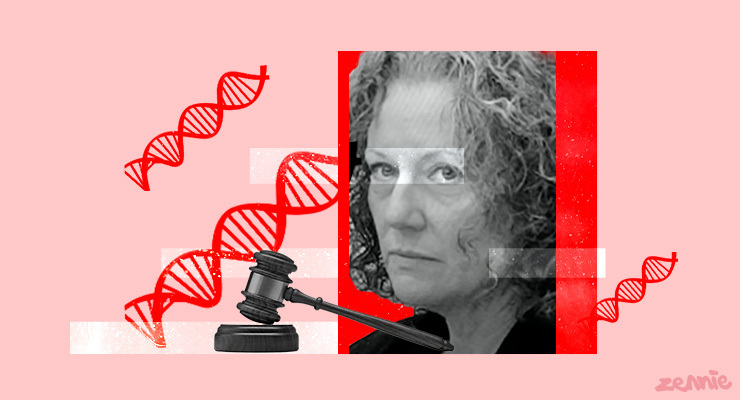
Genetics are at the heart of an adjourned inquiry into the conviction of Kathleen Folbigg, who has spent 19 years behind bars for the murder and manslaughter of her four children. While the court stews over the new science and decides whether a DNA deficiency could have caused her two daughters’ sudden death, Crikey weighs up the broader role of DNA in the courtroom.
Not who, but how
DNA has long been heralded the “gold standard” of forensic evidence for its capacity to fill in the gaps on who committed a crime. The science is settled on who DNA belongs to, but University of Technology Sydney professor of forensic genetics Dennis McNevin said it is hard to conclude why or how DNA lands where it does.
“Just because someone’s DNA is found on an object, doesn’t mean that a) they were guilty and b) they were even present at the time of the crime,” he said.
In short: DNA at a crime scene does not equate to evidence.
There’s all manner of ways your ID can wind up in a room or on a weapon. It could be an innocent interaction with a person or object before a crime was committed, or an unfortunate third-party transfer.
“I might shake the hand of a future offender [and] five minutes after leaving my presence this person picks up a weapon and grips it with my DNA on their palm,” McNevin said. “My DNA is transferred to the weapon even though I never held it, wasn’t at the crime scene, and had nothing to do with the crime.”
It’s ultimately a numbers game: what’s the probability that person X’s DNA drops where it does and therefore what’s the chance of criminal culpability. And if it’s not that person, then DNA has to have come from someone else.
The field of forensic science is making moves to model all manner of DNA transfer scenarios — go here, hold this, touch that — but the cool, calm, collected and controlled nature of laboratory-based experiments are lost on a crime scene.
Take the nerves of an offender, for example. More sweat means more DNA to drop — not necessarily just their own.
Does it stand up to scrutiny?
DNA evidence in the courtroom dates back to 1986 when it exonerated a man accused of raping and murdering two teenage girls and put a positive ID on the real perpetrator.
It typically clears more names than it falsely incriminates, but there are exceptions. In 2008, erroneous DNA evidence led to the false conviction of 19-year-old Somali man for the rape of a middle- aged woman at a plus-30s nightclub. He lived on the opposite side of Melbourne, CCTV footage found no trace of him, none of the bar staff remembered him, and he had a rock-solid alibi, but his DNA turned up on a vaginal swab of the victim and that was evidence enough to convince a jury. It was a case of cross-contamination picked up after the fact.
Flinders University chair and professor in forensic DNA technology Adrian Linacre calls that a human not a science problem: “No other science has been validated to the nth degree in the way that DNA has, but any process that involves a human is always going to be an issue.”
Putting a name to a face in court
Despite its shortcomings, DNA plays an “outsized role” in criminal proceedings. Linacre said juries really lean into DNA evidence, relying on it “a bit too much”.
“They ask: ‘Where is the DNA?’ They don’t often ask: ‘Is there another way that DNA got there?’”
Call it the “CSI effect”, with juries’ crime scene and courtroom know-how pulled directly from pop culture. As a result, DNA has transformed from a tool to say it is or it isn’t you into a “prosecution tool” in and of itself that can be detrimental to fair justice.
“No forensic science should be a prosecution tool,” Linacre said. “It’s an independent process by which you can evaluate the evidence.”
The role of forensic scientists in court is to stand as expert witnesses, impartial to the prosecution and defence. They provide information exclusively under questioning which McNevin said could limit their capacity to educate a courtroom on DNA evidence as one but “not the only form” of evidence.
“They will usually be asked: ‘Does this DNA evidence mean that person shot the weapon?’ Quite often the expert will have to say: ‘No, I can’t say that. All it shows is that their DNA is on the weapon. I can’t say if they shot it.’ ”
Until DNA can better identify how and why, McNevin said the solution was to lean into corroborating evidence: “If DNA is found at a crime scene, and you have CCTV footage, and you have a motive, and an eyewitness account — all those things together should increase the case against a person. It’s very dangerous to convict on DNA evidence alone.”
Do you think Kathleen Folbigg is the victim of a miscarriage of justice? Let us know by writing to letters@crikey.com.au. Please include your full name to be considered for publication. We reserve the right to edit for length and clarity.








DNA is valuable in solving cold cases that is in the past – it is of minimal assistance in immediate crime , proper policing and detective work solves crime, science may be of minor peripheral help.
Blaming the victim of a tragedy is one of society’s biggest sins, and too common. Our dumb ignorance screams, “Disease doesn’t do that!”, “Dingos don’t do that!” Mothers cop it extra hard. The turmoil and shock of your own baby, dead, has to be experienced to understand and believe. Guilt is presumed, not innocence, thanks to sick titillation and gossip – human nature, in fact. Police sometimes withhold evidence in order to convict, also. A notorious case can affect results with public demand for conviction. A poor defence lawyer is your own worst enemy. Kathleen Folbigg? Obviously a victim, but of what?
How does the type of DNA evidence discussed in this article have anything to do with that which is relevant to the case of Kathleen Folbigg?